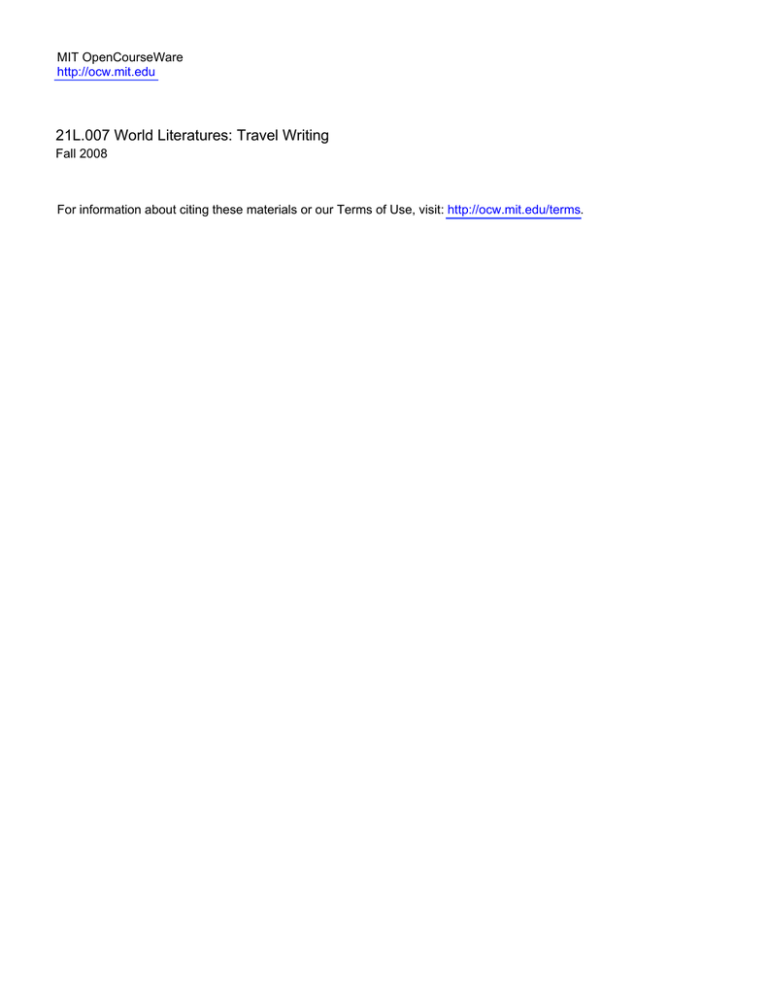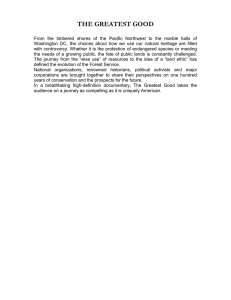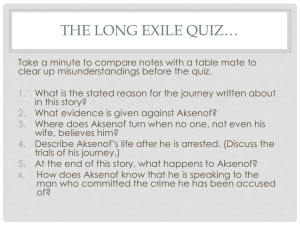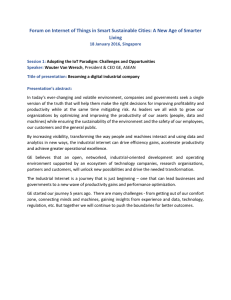21L.007 World Literatures: Travel Writing MIT OpenCourseWare .
advertisement

MIT OpenCourseWare http://ocw.mit.edu 21L.007 World Literatures: Travel Writing Fall 2008 For information about citing these materials or our Terms of Use, visit: http://ocw.mit.edu/terms. Worst Journey: reading for 11/13 Chapter 6 Here are a few key things that you should know. Scott and his team have arrived in the Antarctic with a dual mission: to "discover" the South Pole by being the first ones to reach it, and to do various kinds of science. As they find out only once their own journey south is well advanced, the Norwegian explorer Roald Amundsen was making his own attempt on the Pole at the same time, creating a sense of both urgency and national competition. The chapter opens at the end of the first working season in the Antarctic, during which the team had made a series of journeys in order to lay depots of food and fuel along the path they planned to take towards the Pole the following year. (These were difficult and grueling in themselves). As the Antarctic winter comes on, weather will confine the team close to home, and so this chapter is focused on logistics, scientific observations, the setting of their encampment, and the personalities of key team members. Logistics . On his successful journey to the South Pole, Amundsen used skis and dog teams for transport, both well-known and successful means of travel in arctic environments. He reached the Pole and returned without incident or loss of life. Scott's team came prepared to experiment with using dogs, horses, and motor transport. During the first Antarctic "summer", they used all three. The text suggests that there was a significant learning curve in terms of how to use these different modes of transport in the Antarctic environment (the trucks did not work very well), and particularly how to feed the horses. As the chapter opens, there have been some casualties: the animals purchased for the expedition were not well-chosen, all were stressed by conditions on the sea voyage to the Antarctic (as were the human members), some of the horses have fallen victim to various accidents (including being eaten by killer whales), and all have finished the first working season in very poor condition. As you'll see, Scott felt that horses were the best bet for supplementing human power on the journey to the Pole (a choice which seems deeply counterintuitive from the perspective of the present). However, as he was leaning on his own prior experience in the Antarctic (1901-4), we won’t call him stupid. Daily life . This chapter will also give you a sense of the "routine" of life in the Antarctic (meals, scheduled observations, exercise, etc.), and of the base camp’s surroundings: “beauty … grandeur and immensity.” I found particularly interesting the attention to books (which books will be especially cherished in these circumstances?), but you will notice that in addition to practical jobs like planning and taking observations, there is a good bit of attention to recreation: music, lectures, artwork, etc. Earlier expeditions had discovered that providing activities like these boosted morale, and improved survival. (I will try to show you an example on Thursday). Characters . Cherry pays particular attention to Robert Scott, Bill Wilson, Birdie Bowers, and (this section I'm not assigning) Titus Oates. These four would make up the party that made the final push for the Pole, after the teams supporting them had turned back, and all would die -- along with a fifth man, Edgar Evans, an able seaman. You will see some attention to Scott's character (“full of lights and shades”), and how it affected him as a leader and an explorer. Cherry pays roughly equal attention to psychology and physique, so you will also be able to learn Bower’s chest circumference and weight. Many members of the expedition were either military or naval personnel, generally with experience in India and Southeast Asia. This chapter gives you a view of the expedition at rest. Cherry writes, as he says, many years later, after the death of many of these men either at the Pole or in the First World War. Even before the loss that intervened, however, he looked back on this time as one of the happiest of his life. Chapter 7 There was one exception to the general cessation of travel over the Antarctic winter. Wilson planned an expedition devoted to bringing back embryos of the Emperor Penguins who nested at Cape Crozier; he and others believed that the development of the Emperor would provide crucial information about evolution in general. Specimens had to be collected at a particular stage in their life cycle, thus the winter journey. The journey itself was undertaken by Wilson, Bowers, and Cherry -- all volunteers. They traveled on foot, and if I'm not mistaken, were the first to travel during this season in the Antarctic. It is actually from this far less famous journey, rather than the polar journey, that the book takes its title: The Worst Journey in the World. You will quickly see why. The details get a vivid sense of both the physical and mental experience on this trip. We'll read the first part of the journey out, then skip ahead to their arrival at the Emperor rookery. At the end of this section, they are obviously in extremely dire straits, having lost their tent in a blizzard, but they will manage to find it and survive the homeward journey. In the final piece of the reading (and you must read this) Cherry recalls what happened to the specimens they brought back, nearly at the cost of their lives. Field science meets institutional bureaucracies.







